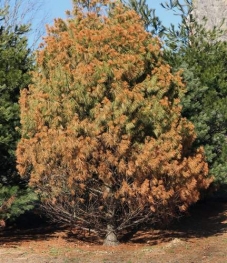
Have you seen trees and shrubs turning brown or ashen gray on one side at the end of winter? You may be looking at winterburn. It's a condition that usually occurs on the south and southwest sides of needled and broadleaf evergreens when winter sunshine heats one side of the plant above the ambient temperature and wrecks havoc on the plant's internal moisture system. The problem is not necessarily fatal once it has occurred, but prevention is better than dealing with it after the fact. Prevention begins with proper moisture and root care in the prior summer, according to arborist Jeremiah Green at The Care of Trees in Hamden and Norwalk.
That is just one of several tree and shrub problems we should scout in early spring, according to Green. Evidence of insects is present now, as well as several diseases.
"People often call this time of year about spruce damage, notably Colorado blue spruces," says Green. “The tree is native to high altitudes and a drier climate. But here, outside of its native range, it can get a disease called cytospora canker.”
“There’s no treatment for cytospora other than encouraging the overall health of the tree,” he says.
Early March is ideal for pruning dead branches on trees and shrubs because the cuts can heal before pathogens become active in spring and summer. This is an especially good time to prune non-flowering deciduous shrubs and shade trees such as maples, oaks, and elms, as well as summer-flowering species such as Rose of Sharon, viburnums, and summersweet. It is also a fine time to prune needled evergreens.
Download the article at the link below.
| Attachment | Size |
|---|---|
| 765.45 KB |
